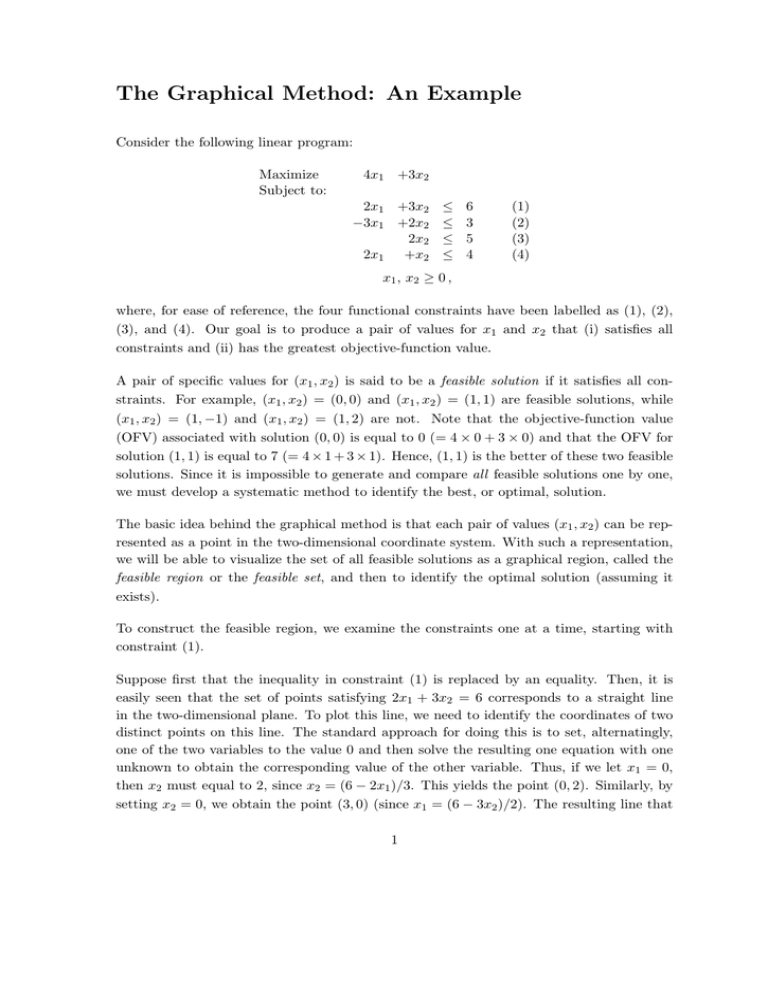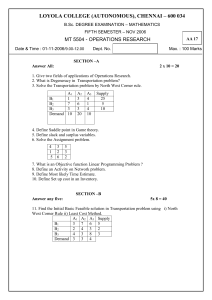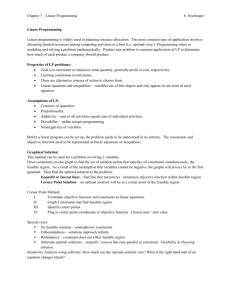The Graphical Method: An Example
advertisement

The Graphical Method: An Example Consider the following linear program: Maximize Subject to: 4x1 +3x2 2x1 +3x2 −3x1 +2x2 2x2 2x1 +x2 ≤ ≤ ≤ ≤ 6 3 5 4 (1) (2) (3) (4) x1 , x2 ≥ 0 , where, for ease of reference, the four functional constraints have been labelled as (1), (2), (3), and (4). Our goal is to produce a pair of values for x1 and x2 that (i) satisfies all constraints and (ii) has the greatest objective-function value. A pair of specific values for (x1 , x2 ) is said to be a feasible solution if it satisfies all constraints. For example, (x1 , x2 ) = (0, 0) and (x1 , x2 ) = (1, 1) are feasible solutions, while (x1 , x2 ) = (1, −1) and (x1 , x2 ) = (1, 2) are not. Note that the objective-function value (OFV) associated with solution (0, 0) is equal to 0 (= 4 × 0 + 3 × 0) and that the OFV for solution (1, 1) is equal to 7 (= 4 × 1 + 3 × 1). Hence, (1, 1) is the better of these two feasible solutions. Since it is impossible to generate and compare all feasible solutions one by one, we must develop a systematic method to identify the best, or optimal, solution. The basic idea behind the graphical method is that each pair of values (x1 , x2 ) can be represented as a point in the two-dimensional coordinate system. With such a representation, we will be able to visualize the set of all feasible solutions as a graphical region, called the feasible region or the feasible set, and then to identify the optimal solution (assuming it exists). To construct the feasible region, we examine the constraints one at a time, starting with constraint (1). Suppose first that the inequality in constraint (1) is replaced by an equality. Then, it is easily seen that the set of points satisfying 2x1 + 3x2 = 6 corresponds to a straight line in the two-dimensional plane. To plot this line, we need to identify the coordinates of two distinct points on this line. The standard approach for doing this is to set, alternatingly, one of the two variables to the value 0 and then solve the resulting one equation with one unknown to obtain the corresponding value of the other variable. Thus, if we let x1 = 0, then x2 must equal to 2, since x2 = (6 − 2x1 )/3. This yields the point (0, 2). Similarly, by setting x2 = 0, we obtain the point (3, 0) (since x1 = (6 − 3x2 )/2). The resulting line that 1 passes through these two points is shown in Figure LP-1. We shall refer to this line as “line (1)”. Observe that line (1) cuts the plane into two half-planes. All points on one side of this line (including the line itself) satisfy 2x1 + 3x2 ≤ 6; whereas on the other side, 2x1 + 3x2 ≥ 6. Note that (x1 , x2 ) = (0, 0) satisfies 2x1 + 3x2 ≤ 6, and that (0, 0) lies in the lower-left direction of line (1). Therefore, we are only interested in the lower-left portion of the plane. (What if (x1 , x2 ) = (0, 0) happens to satisfy a given constraint as an equality?) This is also shown in Figure LP-1. In this figure, next to line (1), we also placed two arrows that point toward the lower-left direction. This is intended to indicate what will be called the “feasible direction”. In summary, after discarding points that violate constraint (1), we are left with the half plane that sits at the lower-left side of the line defined by 2x1 + 3x2 = 6. Thus, each constraint makes a “cut” on the two-dimensional plane, and repeating this process (do this yourself) for the remaining five constraints (the lines x1 = 0 and x2 = 0 correspond to the x2 -axis and the x1 -axis, respectively) yields the feasible set. This is shown in Figure LP-2, where we have shaded the feasible region. Note that constraint (3) is redundant, in that its removal will not have an impact on the shape of the feasible set. The next question is: Which point within the feasible set is optimal? To answer this, we now look at the objective function. Observe that for any given constant c, the set of points satisfying 4x1 + 3x2 = c is again a straight line; and more importantly, that by varying c, we can generate a family of lines (one for each c) with the same slope (i.e., members of this family are parallel). Hence, we can choose an arbitrary c, draw its corresponding line 4x1 +3x2 = c, and then visualize the entire family by “sliding” this line in a parallel manner. In Figure LP-3, we show two such lines: 4x1 + 3x2 = c1 and 4x1 + 3x2 = c2 , where c1 ≡ 12 and c2 ≡ 16. Since both lines do not intersect the feasible region, points on these two lines are not feasible. Note however that the line with the smaller c, namely c1 , is closer to the feasible set. Therefore, if we decrease c further, from c1 , then at some point the resulting parallel lines will eventually touch the feasible region at exactly one point. More precisely, this takes place when the family of objective-function lines hits the intersection of lines (1) and (4), a corner point (or an extreme point) of the feasible set. It is now clear that this corner point, marked as D in Figure LP-3, must be optimal, since we need to lower c still further to “reach” the other points within the feasible set. Finally, we note that point D has the coordinates (3/2, 1) (Why?) and therefore, it has an objective-function value of 9 (= 4 × (3/2) + 3 × 1). This completes the solution of the problem. More generally, observe that regardless of the slope of the objective function, the above process will always lead to an optimal corner-point solution. (This is true even when the objective-function line first touches the feasible set at an entire edge; in such a case, we actually have two optimal corner-point solutions at the end points of that edge.) This 2 implies that we can be assured that an optimal solution (whenever it exists) can always be found at one of the corner points of the feasible set. This fact is remarkable, as it says that we have managed to reduce the task of finding an optimal solution within the entire feasible set, which is a set containing an uncountable number of points, to that of finding an optimal solution within the set of corner points, which is a set containing a finite (why?) number of points. In this particular example, there are only five corner-point solutions, namely points A, B, C, D, and E (see Figure LP-3). Therefore, the reduction in the search effort is truly significant. The above observation naturally suggests the following simple two-step procedure for solving a linear program: Procedure Search Step 1: Identify the coordinates of all corner points of the feasible set. Step 2: Evaluate the objective function at all of these corner points and pick the best solution. In applying Step 1 to the particular problem above, the location of the corner points can be identified via the graph. For problems with three decision variables, one can still attempt to draw three-dimensional graphs. With four or more variables, it becomes impossible to implement the procedure. Therefore, in order for this search procedure to work, we must develop a general method for determining the coordinates of the corner points without relying on a graphical representation of the feasible set; and this will be our next task. In Figure LP-3, the coordinates of all five corner points have been explicitly specified. For example, the coordinates of the optimal corner point, point D, is given as (3/2, 1). How does one determine these coordinates? Of course, we can attempt to determine the coordinates of a given point on a graph by “visual inspection”, but in general, this cannot be expected to yield accurate answers. More constructively, recall that point D is sitting at the intersection of lines (1) and (4). Thus, we can algebraically solve the system of two defining equations, 2x1 +3x2 = 6 2x1 +x2 = 4 , (1) (4) to obtain the coordinates of this intersection. (In other words, the coordinates of this intersection must satisfy both equation (1) and equation (4).) To do this, subtract equation (4) from equation (1) to yield 2x2 = 2, implying that x2 = 1. Next, substitution of x2 = 1 into equation (1) (or alternatively, into equation (4)) shows that x1 = 3/2. This verifies 3 that (x1 , x2 ) = (3/2, 1) is indeed the precise location of point D. You should now verify the coordinates of points A, B, C, and E yourself. It is important to realize that this analysis still depends on the availability of the graph. Specifically, we need to know the identify of the two defining equations for each corner point (i.e., we need to know that equations (1) and (4) together define point D, equations (1) and (2) together define point C, equation (2) and x1 = 0 together define point B, and so on). And we need to know that only these five (Out of how many? See below.) particular combinations of two defining equations give rise to corner points of the feasible region. Therefore, a fundamental question is: Can we free ourselves from the reliance on the graph? A little bit of reflection now leads us to the following procedure: Procedure Corner Points Step 1: From the given set of six equations (including x1 = 0 and x2 = 0), choose an arbitrary combination of two equations. Solve this chosen set of two equations to obtain the coordinates of their intersection. (A unique solution may not exist in general; see discussion below.) Step 2: If the solution in Step 1 satisfies all other constraints, then accept it as a cornerpoint solution; otherwise, discard the combination. Step 3: Repeatedly loop through Steps 1 and 2 until all possible combinations are exhausted. Despite its brutal flavor, it turns out that this procedure, indeed, will allow us to generate the coordinates of all corner-point solutions. To convince ourselves about the validity of this procedure, consider, for example, the choice of equations (1) and (3): 2x1 +3x2 = 6 2x2 = 5 . (1) (3) From equation (3), we have x2 = 5/2, which implies that x1 = (6 − 3x2 )/2 = −3/4. Since the resulting solution (x1 , x2 ) = (−3/4, 5/2) has a negative value for x2 , it is not feasible. Therefore, the combination of equations (1) and (3) does not lead to a corner-point solution. Now, with six equations, it is easily seen that the total number of subsets of two equations is equal to 6 2 ! = 6! = 15 . 2!4! After cycling through all 15 of these combinations and discarding combinations that do not yield a feasible solution, it can be shown that only five combinations remain; moreover, 4 these five combinations correspond precisely to the pairs of defining equations for points A, B, C, D, and E. This establishes (empirically, at least) the validity of the above procedure. Procedure Search and Procedure Corner Points form the backbone of the Simplex method, which is an algebraic procedure for solving linear programs with any (finite) number of variables and constraints. We will return to a full development of this method in a later section. Discussion In general, the feasible region of a linear program may be empty. Procedure Search is meaningful only if the feasible set is not empty. Discovery of an empty feasible set will be discussed later. Consider the linear program: Maximize x1 +x2 , subject to x1 , x2 ≥ 0. Since the values of x1 and x2 are allowed to be arbitrarily large, this problem does not have an optimal solution. Note that the feasible region has exactly one corner point, at (0, 0); and that this corner point is not optimal. This clearly is a contradiction to Procedure Search. A linear program of this type is said to be unbounded ; we will refine the statement of Procedure Search later to deal with such examples. In general, a given pair of straight lines on the plane may not have a unique intersection point. This could occur if the two lines are parallel, in which case there is no intersection, or if the two lines coincide, in which case every point on the line is an intersection point. Algebraically, this means that a given pair of equations may not have a unique solution. For example, the equation pair x1 +2x2 = 3 x1 +2x2 = 6 has no solution; and the equation pair x1 +2x2 = 3 2x1 +4x2 = 6 has an infinite number of solutions. This issue is relevant in Step 1 of Procedure Corner Points, whose statement will also be refined later. 5





